That, in itself, is weird but it gave me the idea to have a brief look at some other aspects of physics that are even weirder but I decided that I would miss out gravity, time dilation and Quantum Entanglement to concentrate on the following and I have to thank Daisy Dobrijevic, Space.com for most of it.The double-slit experiment is one of the most famous experiments in physics and definitely one of the weirdest. It demonstrates that matter and energy (such as light) can exhibit both wave and particle characteristics — known as the particle-wave duality of matter.Christian Huygens was the first to describe light as traveling in waves whilst Isaac Newton thought light was composed of tiny particles. Thomas Young designed the double-slit experiment to put these theories to the test.Light passes through the slits. On the far side of the divider, the light from each slit diffracts and overlaps with the light from the other slit, interfering with each other.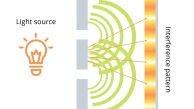
If you were to carry out the same experiment and fire grains of sand or other particles through the slits, you would end up with a different pattern on the sensor screen.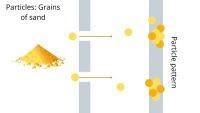
If you block off one of the slits, so it is just a single-slit experiment, and fire photons through to the sensor screen, the photons will appear as pinprick points on the sensor screen, mimicking the particle patterns produced by sand in the previous example. From this evidence, we could suggest that photons are particles.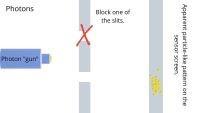
If you unblock the slit and fire photons through both slits, you start to see something very similar to the interference pattern produced by waves in the light example. The photons appear to have gone through the pair of slits acting like waves.But what if you launch photons one by one, leaving enough time between them that they don't have a chance of interfering with each other, will they behave like particles or waves?At first, the photons appear on the sensor screen in a random scattered manner, but as you fire more and more of them, an interference pattern begins to emerge. Each photon by itself appears to be contributing to the overall wave-like behavior that manifests as an interference pattern on the screen — even though they were launched one at a time so that no interference between them was possible.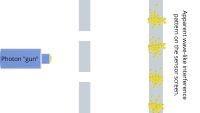
If you fire photons through both slits whether it be all at once or one by one, they appear on the sensor screen in a wave-like interference pattern. It's almost as though each photon is "aware" that there are two slits available. How? Does it split into two and then rejoin after the slit and then hit the sensor? To investigate this, scientists set up a detector that can tell which slit the photon passes through.Again, we fire photons one at a time at the slits, as we did in the previous example. The detector finds that about 50% of the photons have passed through the top slit and about 50% through the bottom, and confirms that each photon goes through one slit or the other. Nothing too unusual there. But when we look at the sensor screen on this experiment, a different pattern emerges.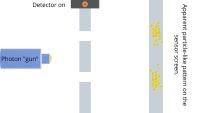
When the detector is turned on, the photons produce a particle-like pattern on the sensor screen. This pattern matches the one we saw when we fired particles through the slits. It appears that monitoring the photons triggers them to switch from the interference pattern produced by waves to that produced by particles.If the detection of photons through the slits is apparently affecting the pattern on the sensor screen, what happens if we leave the detector in place but switch it off? This is where things get really, really weird.Same slits, same photons, same detector, just turned off. Will we see the same particle-like pattern? No. The particles again make a wave-like interference pattern on the sensor screen.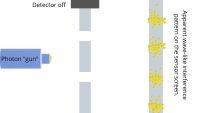
When the detector is switched off the photons make a wave-like interference pattern on the sensor screen. The atoms appear to act like waves when you're not watching them, but as particles when you are. How? Well, if you can answer that, a Nobel Prize is waiting for you.This video may help. My hero Professor Jim Al-Khalili has a go in: Double-slit experiment explained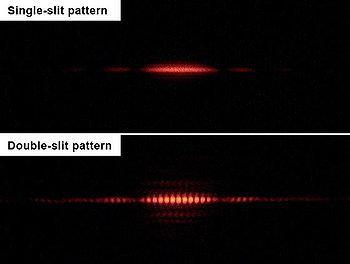
This may not explain things:
Probably a Poem about Quantum Mechanics
I
In Classical Mechanics
a reader is presented
with words forming a pattern
on a single page
and by following the lines
formed by these words
will confidently expect
that at the end of the last line
there will be a verse
II
In Quantum Mechanics
a reader is invited
to close their eyes
as words are printed
on a single page
then when told to look
will see a familiar pattern
and by following the lines
will confidently expect
that at the end of the last line
there will be a verse
III
In Quantum Mechanics
a reader is encouraged
to keep their eyes open
and observe a word
while it is being printed
such encouragement may be needed
as the act of interactingwith any word in any way
will lead to the collapse
of the verse pattern
and thus a poem may
or may not occur
we just don’t know
First
published in The Journal, August 2019Thanks for reading, Terry Q
Email ThisBlogThis!Share to TwitterShare to Facebook
